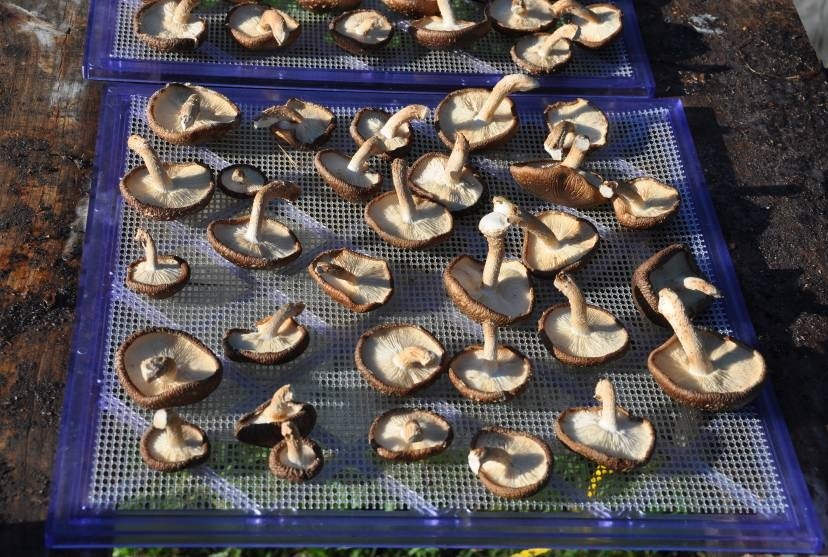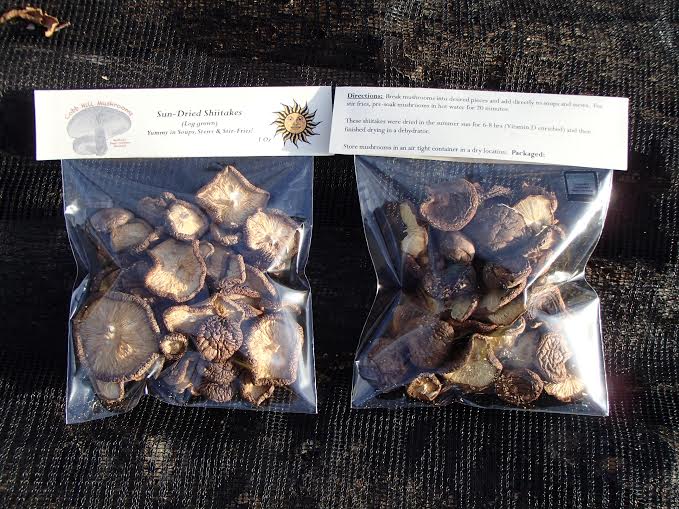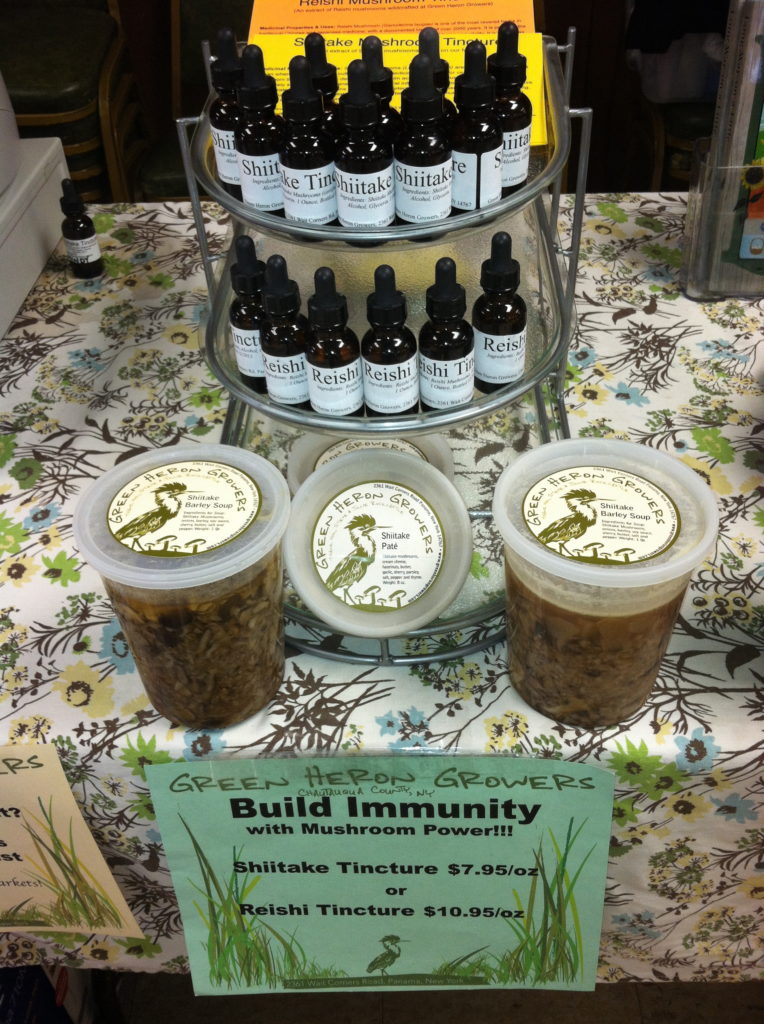Storage & Preservation
EXPERT TIPS: Storing Fresh Shiitake
Stainless steel hotel pans have become our preferred storage container because they are large and come in various sizes. To control moisture in the bottom of the pans we put down a layer of paper towel, but leave the top open. If we have to hold mushrooms a week or more, we’ll transfer them to clean pans occasionally and replace the paper towels. This helps to make sure they have good air circulation around them, too. We use baskets in the fridge at times, but have found that the fiber baskets start to mold pretty quickly. Those are reserved now for harvesting. Paper bags don’t work well for long, unless you deliver or sell your mushrooms the day or so after harvest. This, of course, is the best-case scenario! One factor that I don’t think we’ll ever be able to account for is shrinkage from dehydration in the fridge. What we harvest and what we sell can be quite different depending on how long they are refrigerated. That brings down the “income per pound” by some percentage unknown.
-Steve and Julie Rockcastle, Green Heron Growers
“It’s been my experience this year that wax-lined cardboard boxes are the best way to store mushrooms in the refrigerator. I have been getting boxes from my restaurants. They typically have several openings to allow air flow through the box during storage.
One thing I’ve learned is not to put too many mushrooms in a box. For example, I can fit about 6 to 7 pounds in a typical box (15”x20”x4”) and that’s about it. Mushrooms keep very well in a fridge, if stored properly, with some air flow. If you overcrowd fresh mushrooms the bottom ones won’t get any air flow and they’ll head south sooner that you’d like them to.”
- Matt Anderson, Tyrrel Mushroom Farm
EXPERT TIPS: Drying Shiitake
“One of the best uses of shiitake over-age is dehydrating. We used to dry them whole, but now slice them, by hand. We leave as much or the stem intact that is soft and not woody. The labor required is a factor, but we slice them because our customers prefer them that way and because we can cut out damaged areas of perfectly tasty mushrooms. We had a “American Harvester” dehydrator that worked up until this year and now have an “Excaliber” with 9 trays. Each batch can start with 5-7 pounds fresh. The mushrooms overlap on the trays quite a bit, but reduce so quickly it doesn’t seem to matter. A batch takes 6-8 hours at 95 degrees. Last year we dried 100 fresh pounds and got 14 pounds dried. We trying the oven a couple times at 200 degrees, but I’d say they were close to burnt and flavorless. We have also tried sun-drying in our greenhouse, but it took more than one day and we felt there was too much risk of insects contaminating them.”
- Steve and Julie Rockcastle, Green Heron Growers
Mushroom Storage Techniques
Storing the fresh mushrooms
For a high-quality mushroom, it is important to get the harvested mushrooms into refrigerated storage as soon as possible, certainly within one hour of picking. These mushrooms will remain fresh and marketable for several weeks, if kept in a cool (41°F), dry and dark place. Do not seal them in an airtight container. A paper bag (not plastic) works very well. Keep in mind that mushrooms will dry out and lose weight the longer they are stored. See sidebar for more information.
Freezing Shiitake Mushrooms
Mushrooms need to be treated to stop maturation before freezing, usually by steaming or sauteing. Soak mushrooms in a mixture containing 1 teaspoon lemon juice or 1.5 teaspoons citric acid per pint of water for 5 minutes to reduce darkening. Steam whole mushrooms for 5 minutes, buttons or quarters for 3.5 minutes and slices for 3 minutes. Cool promptly, drain and package, leaving 1/2-inch headspace. Place small packages in the freezer for fast cooling.
Drying Shiitake Mushrooms
Dry shiitakes are an excellent way to bring seconds to the market. Any mushroom with cosmetic defects can be dried, but mushrooms that are molding or have excessive beetle or other damage that compromises taste should be avoided and discarded.
Drying can preserve large quantities of mushrooms up to a year. The dried mushroom has a moisture content of approximately 13 percent and weighs about one seventh the original fresh weight. Separate mushrooms by size and grade. Remove stems completely, as they harden when they dry. Place mushrooms on trays with gills up. Avoid allowing the mushrooms to touch each other.
- Sun Drying / Outdoor Drying
Advantages: Low-cost, simple, increased vitamin D content in mushroom
Disadvantages: Depends on weather; can be slow process
Method: Spread the shiitake on shelves so that the gills are directly exposed to sunlight. You can also string them using thread or fishing line and then hang and dry them in a breezy, dry spot. Length of time required will vary depending on the weather conditions.
- Dehydrator / Home Food Dryer
Advantages: Simple process, quick drying time
Disadvantages: Energy intensive, only handles small quantities (2 to 3 pounds fresh shiitakes)
Method: Follow the instructions that come with the dehydrator. You have to ensure that you dehydrate your mushrooms until they are light and dry, but not brittle. They should be slightly flexible.
- Oven / Thermal Drying
Advantages: Best quality, quick
Disadvantages: Requires special equipment and a fuel source
Method: Arrange the mushrooms on shelves with the gills facing upwards. The drying chamber should be maintained at 100-125°F for 24 hours. The mushrooms should then be cooled for one hour before being stored long-term. Once dried, the shiitake should be put into polyethylene bags, sealed and kept in a dry, cool, dark place. If drying the mushrooms in your oven, set the temperature to 200°F and keep the door ajar.

Value-Added Products


EXPERT TIPS: Value Added Shiitake
“We regularly have shiitake leftover from farmer’s markets, that are still useful and flavorful, or mushrooms that have damage from pests, that we don’t want to sell fresh. Also, sometimes the harvest is just more than we know what to do with, as a fresh product, and it’s become our solution to preserve them. We have a separate kitchen from our home kitchen that is licensed by New York State Ag & Markets as a 20-C Food Processing Facility. In order to dry and then sell dried shiitake or cook them and make value added products; we must be licensed in NY State.
We have two great shiitake recipes that we make in large batches, then freeze in pint and quart deli containers and transport to farmers markets. One is Shiitake Hazelnut Pate and the other is Shiitake Barley Soup. Both sell really well, especially when customers can taste test them! Sometimes we don’t have time or supplies to make the end products and just slice 5 pound batches of shiitake, sauté them in butter or olive oil and freeze for later use. “Duxelle” is a simple sauté recipe that can be made in small batches for home use later on or to freeze and sell also.
Tincture made with shiitake is also a very successful product for us. An herbalist friend taught us how to make our first batch of tincture. Shiitake mushrooms are well known as a “super food”, but they also have medicinal benefits. Shiitake mushroom tincture works as a deep immune system activator. Shiitake have been extensively studied for use against cancers and viral infections. Compounds found in Shiitake have demonstrated many other actions including liver protection, blood pressure & cholesterol lowering, and anti-fungal properties.
- Steve and Julie Rockcastle, Green Heron Growers
Value-added products can include dried mushrooms and any kind of cooked or baked product with mushrooms – a shiitake pâté or sauce for example. Value-added products can be a great way to diversity your income and increase your profits.
The production and sales of these types of processed foods is governed by state and federal regulations. Each state is different, so proper advice is needed from a specialist in each state. Some states allow sales at farmers markets of select foods; others prohibit sales altogether.
Depending on how much product you sell annually, you will be required to process your product in a licensed kitchen. Home kitchens are not usually considered appropriate for processing purposes. In most states, in order to sell your homemade products on a commercial basis, you’ll need to have your kitchen meet commercial grade kitchen standards and pass a health department inspection, like a restaurant. The process of converting a home kitchen can easily cost upwards to $50,000. There are, however, ways around this:
Canneries and licensed kitchens
Prepare your batches in kitchen that is already licensed. Some people rent restaurant kitchens during their off hours and do the prep and canning there. In some cases, a local cannery is the way to go. If they are licensed as a commercial kitchen (and many are), then you will be able to avoid the need and expense to rent a restaurant kitchen.
Copackers
Copackers manufacture and package foods for other companies to sell. These products range from nationally known brands to private labels. Entrepreneurs choose to use the services of copackers for many reasons. Copackers can provide entrepreneurs with a variety of services in addition to manufacturing and packaging products. They can often help in the formulation of the product. The copacker may function only as a packer of other people’s products or may be in business with his own product line. They may be, in fact, manufacturing several competing products. The range of services available from a copacker will vary depending on the size and experience of the copacker and the type of facilities and the capacity of their plant.
RESEARCH: Medicinal Properties of Shiitake Mushrooms
Flavonoids, a class of chemical compounds found in foods, have received attention for their association with beneficial health effects in humans. the flavonoid concentration in shiitake mushrooms was found to be comparable to the peel of apples (the peel is the site of the greatest concentration of health promoting compounds). while the wives tale suggests that “an apple a day keeps the doctor away”, it may be more appropriate to say that “a mushroom a day keeps the doctor away”.
(adapted from thesis research by B. Sobel (2013) of Cornell University)

